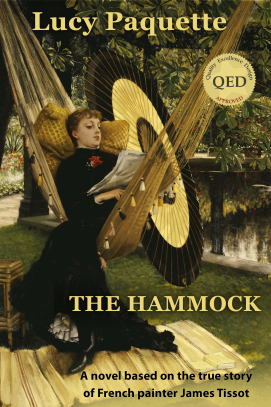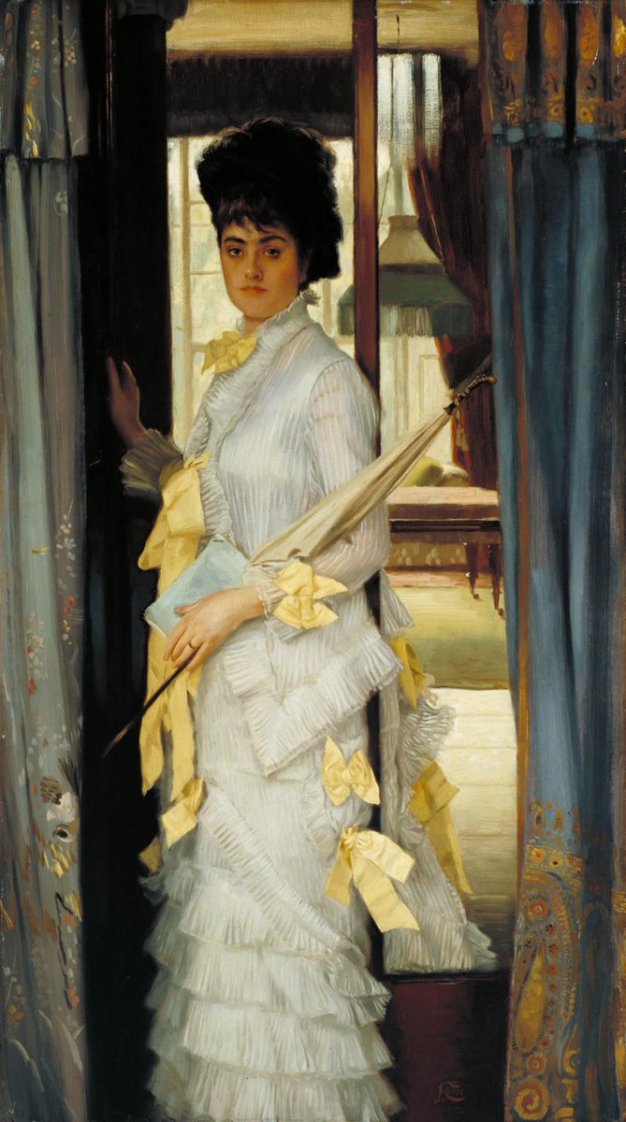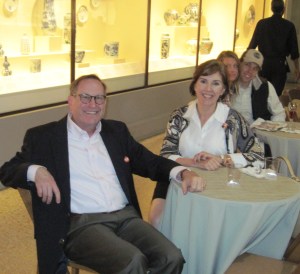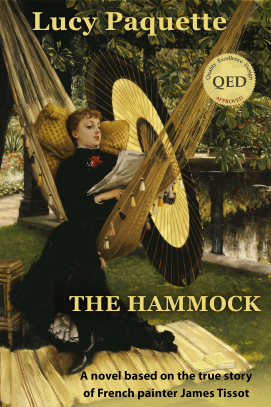To cite this article: Paquette, Lucy. “The few images of people of color by the Impressionists and James Tissot.” The Hammock. https://thehammocknovel.wordpress.com/2020/06/15/the-few-images-of-people-of-color-by-the-impressionists-and-james-tissot/. <Date viewed>.
How hard is it to think of an Impressionist painting that features a black model?

Baudelaire’s Mistress, Reclining (Jeanne Duval, 1862), by Édouard Manet. Oil on canvas, 90 by 113 cm. Szépművészeti Múzeum, Budapest, Hungary. (Wiki)
And yet, surely you’ve seen Manet’s painting, Baudelaire’s Mistress, Reclining (1862). That skirt! The subject, Jeanne Duval, is no shrinking violet; in fact, her bold posture and frank gaze makes the aristocratic Berthe Morisot seem timid in Manet’s Repose (c. 1871).

Repose (c. 1871), by Édouard Manet. Rhode Island School of Design Museum
Jeanne Duval was born in Haiti in the 1820s. Duval’s grandmother, a slave from Guinea, was sent to Europe to work in a brothel, and it’s likely that Jeanne’s father and grandfather were both white.
When she moved to France, she played bit parts at a small theater in the Latin Quarter, where she met the man who would become known as the photographer Nadar. She was Nadar’s mistress in 1838-39, when he was 18 and 19. In 1842, his friend, a free-spending dandy named Charles Baudelaire, saw her perform and was immediately infatuated with her; she became his “mistress of mistresses.”
Scholarly articles by Marc Christophe (1990) and Therese Dolan (1997) shed light on their intense and stormy twenty-year relationship, and Duval was the subject of a major exhibition at the Scottish National Portrait Gallery in 2003 based on the work of poet, artist, photographer and historian Maud Sulter.

Jeanne Duval (c. 1850), by Charles Baudelaire
Nadar, who did not photograph Duval, described her in terms equally sexist and racist which are only hinted at in this brief excerpt: “A tall, almost too tall girl…A special dish for the ultra-refined palate. Beneath the impetuous luxuriance of her ink-black and curling mane, her eyes, large as soup-plates, seemed blacker still…She looked serious, proud, even a bit disdainful. Her figure was long-waisted, graceful and undulating as a snake…”
Gustave Courbet painted Duval standing next to Baudelaire in The Artist’s Studio (1854-55, Musée d’Orsay), but the figure was removed at the poet’s request after a quarrel. Four years later, Duval suffered a stroke. In 1862, Baudelaire told his mother his liaison with Duval was over, but three years later, while in Brussels, he made a pen and ink drawing of her (below) from memory.

Portrait of Jeanne Duval (1865), by Charles Baudelaire. Pencil and ink, 20.6 by 14.5 cm. Musée d’Orsay (Wiki)
Manet exhibited his painting of Duval in 1865, at the Galerie Martinet. Nadar claimed to have last seen Duval around 1870, on crutches and rapidly declining from syphilis. (Baudelaire, who had shown symptoms of syphilis from the time he met Duval, died from its effects in 1867.) Manet’s untitled, undated picture was found in his studio after his death in 1883, and his wife, Suzanne, helped the notaries to title it merely Baudelaire’s Mistress for their inventory. A small watercolor version is in the collection of the Kunsthalle Bremen, Germany.
In 1861 or 1862, Manet painted a black nurse with the little girl on the right in Children in the Tuileries Gardens (Rhode Island School of Design Museum). Only recently has the woman been identified as Laure; Manet described her as a “very beautiful black woman” and recorded her address in a studio notebook.

Children in the Tuileries Gardens (c. 1861-62), by Édouard Manet. Oil on canvas, 37.8 x 46 cm (14 7/8 x 18 1/8 inches). Rhode Island School of Design Museum.
In 1862, Manet painted a bust-length portrait of an unnamed woman, La Négresse, now subtitled Portrait of Laure (Pinacoteca Giovanni e Marella Agnelli Gallery, Turin, Italy), which later was owned by Manet’s one-time student, Éva Gonzalès.
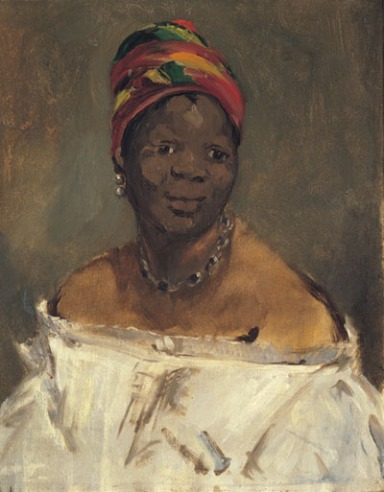
La Négresse (Portrait of Laure), by Édouard Manet. Oil on canvas, 61 by 50 cm (24 by 20 in.). Pinacoteca Giovanni e Marella Agnelli Gallery, Turin, Italy (Wiki)
And now we know it is Laure who modeled for the maid in Olympia, which Manet exhibited at the Salon in 1865.
An important work on the black female body is “Olympia’s Maid: Reclaiming Black Female Subjectivity,” written in 1992 by American artist and critic Lorraine O’Grady. But it was Denise Murrell who discovered that this black woman was named Laure, a “free, wage-earning woman” who lived among the Impressionists in the Batignolles neighborhood of Paris, in researching her 2014 thesis, “Posing Modernity: The Black Model from Manet and Matisse to Today.”
This research was the basis for an exhibition of the same name held at Columbia University’s Wallach Art Gallery in New York from October 24, 2018 – February 10, 2019. Dr. Murrell, the museum’s first Ford Foundation Postdoctoral Research Scholar, curated the show. An expanded version, “The Black Model, from Géricault to Matisse,” was held at the Musée d’Orsay from March 26 – July 14, 2019, and Dr. Murrell was a co-curator. In January of this year, she began her new post of associate curator for 19th- and 20th-century art at the Metropolitan Museum of Art in New York, making her the first full-time black curator on the Met’s staff.

Olympia (1863), by Édouard Manet. Oil on canvas, 130 by 190 cm. Musée d’Orsay. (Wiki)
In 1869 or 1870, Frédéric Bazille painted La Toilette, featuring an exotically-garbed black servant in the foreground, viewed from the back and partially nude. He believed the Salon jury would be impressed by this Orientalist touch, and so he spared no expense. “I have found a ravishing model who is going to cost me an arm and a leg,” he wrote to his mother, “10 francs a day plus bus fare for her and for her mother who accompanies her.” He later added the figure on the right, believed to be Lise Tréhot, Renoir’s companion and model. The jury rejected this work for the Salon in 1870, perhaps punishing Bazille for a painterly style too similar to Manet’s.

La Toilette, by Frédéric Bazille. Oil on canvas, 52 by 50 in. (132 by 127 cm). Musée Fabre, Montpellier, France. (Wiki)
Bazille also painted his new model in modern attire in Young Woman with Peonies (National Gallery of Art, Washington, D.C.) in 1870, giving the completed canvas to his friend, the musician and art collector, Edmond Maître.

Young Woman with Peonies (1870), by Frédéric Bazille. Oil on canvas, 60 by 74 cm. National Gallery of Art, Washington, D.C.
A second version of this painting is known as African Woman with Peonies. Though the model is unknown, it is striking that Bazille featured her in these attentive character studies. She, with her expressive eyes, hands and self-possessed demeanor, is the subject of both canvases, amid the Dutch-inspired floral still life. Who knows how else he may have depicted this woman who knew her own worth and whom he valued, had he not been killed in the Franco-Prussian War in 1870, at age 28? His family kept this painting until his brother gifted it and La Toilette to the Musée Fabre in Montpellier in 1918.

African Woman with Peonies (1870), by Frédéric Bazille. Oil on canvas, 60 by 75 cm. Musée Fabre, Montpellier, France. (Wiki)
Another artist who was killed in the Franco-Prussian War, Henri Regnault, painted a black model, a man, in a grisly work, Execution without Judgment under the Moorish Kings (1870, Museé d’Orsay). Regnault’s image is, however, in the Orientalist tradition of painters like Eugène Delacroix and Jean-Léon Gérôme rather than a depiction of a contemporary black person like Bazille’s woman arranging peonies.

Execution without Judgment under the Moorish Kings (1870), by Henri Regnault. Oil on canvas, 301 by 143 cm. Museé d’Orsay. (Wiki).
In 1871, when James Tissot left the turmoil of war-torn Paris for London, his American-born friend who lived there, James Whistler, famously painted his mother. In a 2018 article for BBC Culture, American poet and art critic Kelly Grovier wrote of Whistler’s “penchant for racist remarks and his fondness for slapping abolitionists in the face. The artist of course shouldn’t be tarred by the appalling allegiances of his brother, who wore the grey uniform of the Confederacy in its doomed efforts to perpetuate slavery, but the fact adds context. Whistler’s mother herself, who once tried to stop the black wife of her uncle and their children from acquiring family land, makes an ironic subject for a painting whose official title, on reflection, feels more than a little racially charged: Arrangement in Grey and Black.”
A reviewer for for James Abbott McNeill Whistler: A Life, by Gordon Fleming (New York: St. Martin’s Press, 1991), wrote, “This withering biography knocks Whistler (1834-1903) off a pedestal. The man [was] a combative hothead given to fistfights, a racist who once punched a Haitian in the face simply because he was black.”
A 2001 review in the Hartford Courant of an exhibition of Whistler’s lithographs at the Wadsworth Atheneum Museum of Art begins with the curator’s observation, “James McNeill Whistler was not a nice man.” The reviewer comments, “Even though Whistler, a West Point dropout and native of Lowell, Mass., was safely out of the country, happily pursuing a bohemian life in Europe during the Civil War, he remained a stalwart supporter of the Confederate cause and remained a virulent racist throughout his life.”
It appears there are no images of people of color in Whistler’s work.

Courtyard of a House (New Orleans, a sketch), also known as Children on a Doorstep, 1872, by Edgar Degas. Oil on canvas, 60 by 73.5 cm. Ordrupgaard, Copenhagen, Denmark. (Wiki)
Tissot’s good friend Edgar Degas visited New Orleans during the Reconstruction period from late October 1872 to early March 1873; his Creole mother’s family, the Mussons, lived there, but another branch of the family that lived there was black, as discussed in a 1999 review in the New York Times of “Degas and New Orleans: A French Impressionist in America,” at the New Orleans Museum of Art. Degas’ maternal grandfather was born in Port-au-Prince, Haiti, of French parentage into the wealthy planter class and had made a fortune in Louisiana cotton. Degas’ mother died when he was thirteen, and he was visiting her younger brother, Michel Musson, who lived in a rented mansion and kept black servants. Edgar’s brother, René, had joined Michel’s cotton business and married one of his daughters, Estelle. The extended family lived together.
Art critic and scholar Christopher Benfey, author of Degas in New Orleans: Encounters in the Creole World of Kate Chopin and George Washington Cable (Berkeley: University of California Press, 1997), previously had “set the city astir by revealing that a branch of the Degas family in this city is descended from a black woman, Constance Vivant, who had six children with Vincent Rillieux, a brother of Degas’s maternal grandmother. One of the children, Norbert Rillieux, became a prominent engineer responsible for advances in sugar refining.” [The reviewer notes, “Neither the Rillieuxes nor the Mussons knew of each other before Mr. Benfey’s book.”]
The reviewer adds, “Mr. Benfey’s book went on to point out the membership of several of Degas’s close relatives here, including René, in the Crescent City White League, a fundamentally racist group bent on wresting political power from the more diverse (if no less corrupt) post-Civil War carpetbaggers…Degas himself wrote frequently in his letters home about black people observed in the street, black women taking care of white children. But with the exception of one partly obscured figure in one painting, he didn’t paint them.”
That painting is Courtyard of a House (New Orleans, a sketch), also known as Children on a Doorstep (Ordrupgaard, Copenhagen, Denmark), which depicts a black nurse watching children of varied skin tones in the large Musson household in the French Quarter in 1872. Degas’ letters from New Orleans to his friends in Paris discussing “the black world” use racist terminology (such as “quadroon” and “forests of ebony”). He notes of the racial mingling in this Southern city, “I shall be very surprised to live among white people only in Paris.”
In 1873, Degas painted A Cotton Office in New Orleans (Musée des beaux-arts de Pau, France), which portrays Michel Musson with his partners and others, including Degas’ brothers René and Achille. It was exhibited in the second Impressionist show in Paris in 1876 and was the first painting by an Impressionist to be purchased by a museum, the newly-founded Musée des beaux-arts de Pau, France, in 1878.

Miss La La at the Cirque Fernando (1879), by Edgar Degas. Oil on canvas, 117.2 by 77.5 cm. National Gallery, London. (Wiki)

Miss Lala (1880) (Wiki)
Several years later, Degas painted a circus performer of mixed race, a petite twenty-one year old woman named Olga Brown, known as Miss La La, who had been born in Stettin (now in Poland) to a black father and a white mother.
She began performing at age 9, eventually touring circuses and music halls throughout Europe and also performing at London’s Royal Aquarium central hall and Manchester’s Gaiety Theatre. A 2007 article by Marilyn R. Brown reveals much more about her.
In January 1879, Degas attended several of this superstar’s aerial performances at the Cirque Fernando in Montmartre. Suspended from a rope clenched between her teeth, the exceptionally strong acrobat was raised seventy feet toward the circus’s domed ceiling. Degas made multiple studies, in graphic, pastel, and oil, of Miss La La and the circus building, and she visited his studio in the rue Fontaine, near the Cirque Fernando. In his diary, he referred to her as “my beautiful negress.” A pastel study at the Getty shows how he lightened the performer’s skin tone in the completed painting, which focuses on her dramatic feat. He identified her only by her stage name.
The painting was first shown at the Fourth Impressionist Exhibition in Paris in 1879.

Miss Lala at the Fernando Circus (1879), by Edgar Degas. Pastel on faded blue paper, 46.4 by 29.8 cm (18 1/4 by 11 3/4 in.) Getty Open Content.
An 1883 poster advertises Miss La La’s performances, twice a day, at the Hippodrome at the Pont de l’Alma, the setting of James Tissot’s painting of [white] performers in glittering costumes, Women of Paris: The Ladies of the Chariots, exhibited in Paris in 1885 and in London in 1886.
Tissot seems to have made friends easily and maintained numerous mutually satisfying relationships over many years – with both men and women, of varied ages, religions, sexual orientations, backgrounds, and temperaments. But there is no documentation on his views on race or any relationships he might have had with people of color, and in his paintings of groups that included soldiers, sailors, dock workers, and servants, all the figures are white.

Beating the Retreat in the Tuileries Gardens (1867), by James Tissot. Oil on panel. Private collection. (Photo: Wikipaintings.org)
But James Tissot made one image of a person of color: the Zouave drummer of the Imperial Guard who is the main figure in Beating the Retreat in the Tuileries Gardens (1867, private collection). In late 1854, Napoléon III ordered a special regiment, the Zouaves of the Imperial Guard, created from the Zouave regiments in the French Army. These Zouaves, by this time native Frenchmen stationed in Algeria, originally were members of the fierce Kabyli tribe of Zouaoua living in the rocky hills of Algeria and Morocco who had volunteered to fight with the French colonial army in 1830. Formed on March 15, 1855, the Zouaves of the Imperial Guard served through all the campaigns of the Second Empire, including the Franco-Austrian War of 1859 and the Mexican Intervention (1864-66). The Zouaves earned a reputation for reckless bravery, and they became famous for their distinctive uniforms, which included a short, collarless, open-fronted jacket, baggy trousers, sashes and Oriental head gear, modeled on Algerian native dress.
In this one picture, Tissot the Realist painter gives us a glimpse of a moment he engaged with a person of color, whom he clearly respected: he made a detailed, sensitive and fairly large oil study of the man, inscribed with his name and military unit, Jousef/Ben Moustapha/3ième Bataillon. Tissot exhibited the painting at the Salon in 1868, where it was purchased for 7,000 francs by the emperor’s cousin, Princess Mathilde.
© 2020 by Lucy Paquette. All rights reserved.
The articles published on this blog are copyrighted by Lucy Paquette. An article or any portion of it may not be reproduced in any medium or transmitted in any form, electronic or mechanical, without the author’s permission. You are welcome to cite or quote from an article provided you give full acknowledgement to the author.
Related posts:
The Company He Kept: James Tissot’s Friends
“Chi-so”: Tissot teaches a brother of Japan’s last Shogun, 1868

If you do not have a Kindle e-reader, you may download free Kindle reading apps for PCs, Smartphones, tablets, and the Kindle Cloud Reader to read The Hammock: A novel based on the true story of French painter James Tissot. Read reviews.
The Hammock: A novel based on the true story of French painter James Tissot, brings Tissot’s world from 1870 to 1879 alive in a story of war, art, Society glamour, love, scandal, and tragedy.
Illustrated with 17 stunning, high-resolution fine art images in full color
Courtesy of The Bridgeman Art Library
(295 pages; ISBN (ePub): 978-0-615-68267-9). See http://www.amazon.com/dp/B009P5RYVE.























 If you do not have a Kindle e-reader, you may download
If you do not have a Kindle e-reader, you may download 
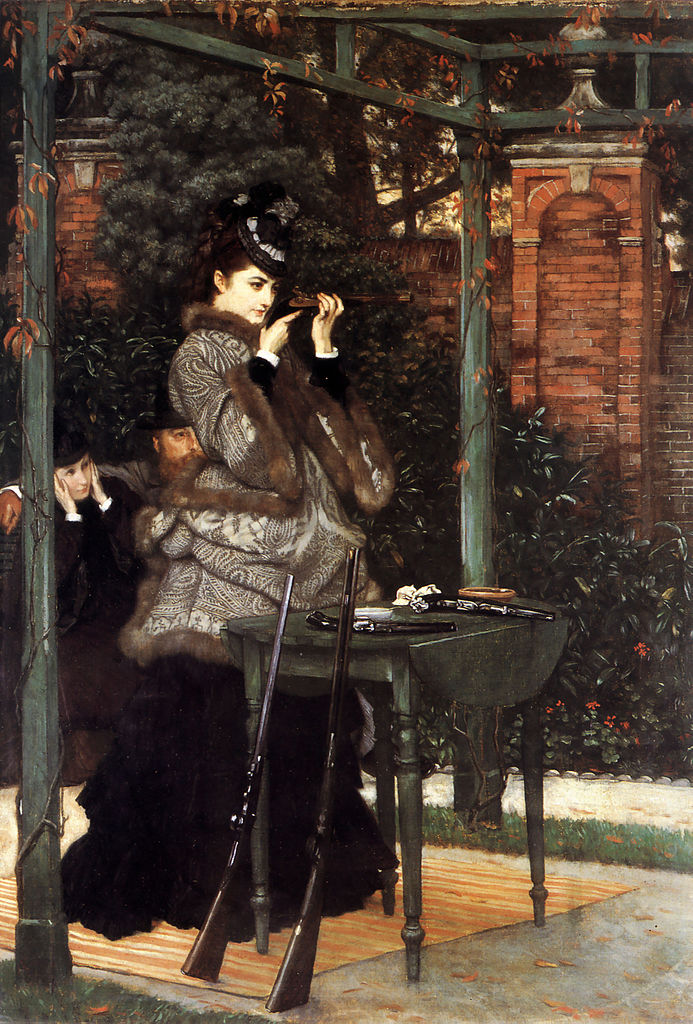





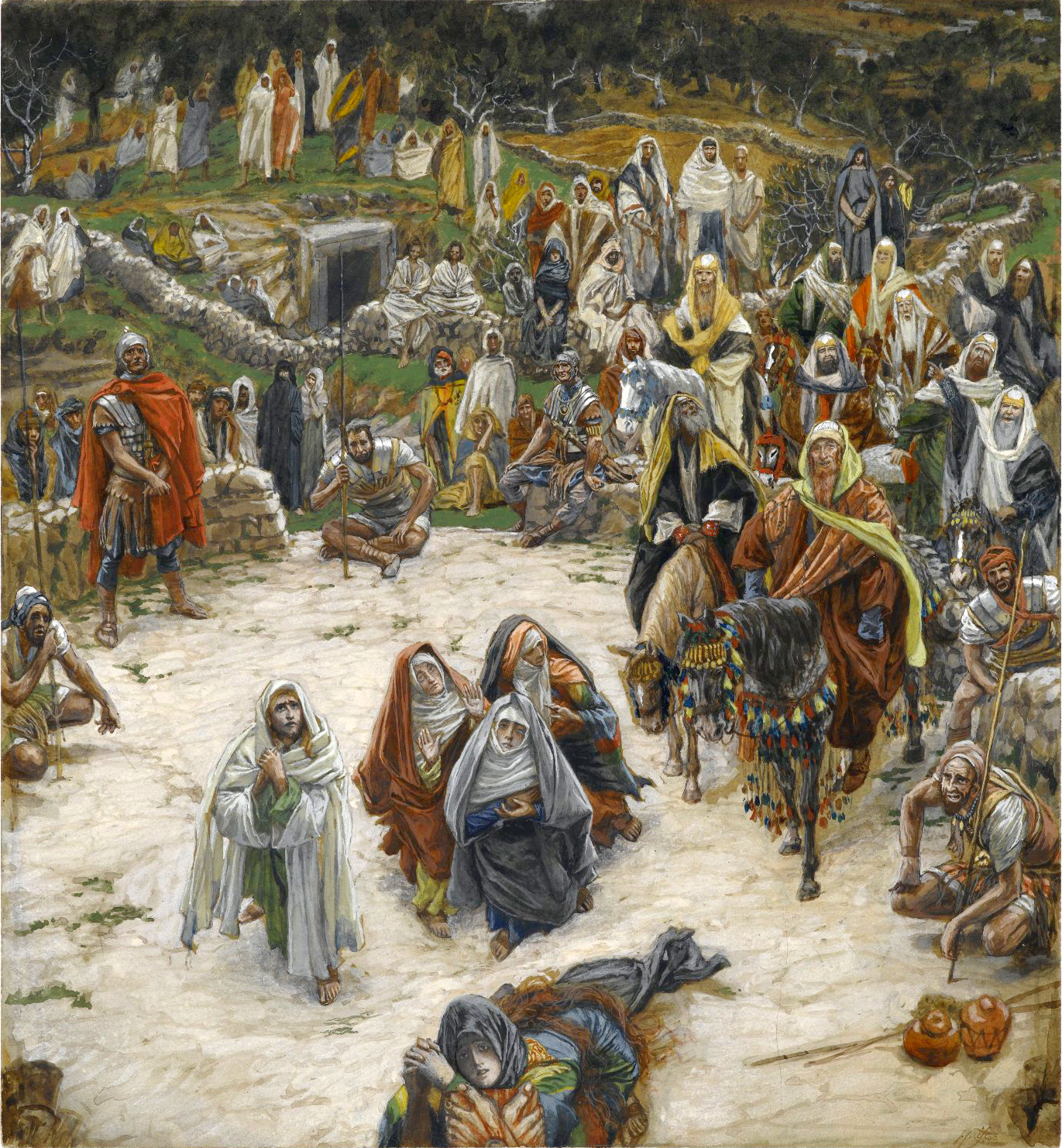


 Tissot and his friend Edouard Manet traveled to Venice together in the fall of 1874, and Tissot bought Manet’s
Tissot and his friend Edouard Manet traveled to Venice together in the fall of 1874, and Tissot bought Manet’s 








.jpg)

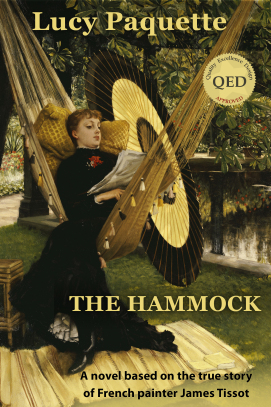


.jpg)


.jpg)




























.jpg)









.jpg)

















